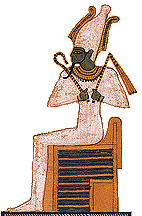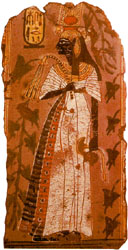Color
(iwen)
In ancient Egypt, color was an integral part of the substance and being of everything in life. The color of something was a clue to the substance or heart of the matter. When it was said that one could not know the color of the gods, it meant that they themselves were unknowable, and could never be completely understood. In art, colors were clues to the nature of the beings depicted in the work. For instance, when Amon was portrayed with blue skin, it alluded to his cosmic aspect. Osiris' green skin was a reference to his power over vegetation and to his own resurrection.

Of course, not every use of color in Egyptian art was symbolic. When overlapping objects, such as when portraying a row of oxen, the colors of each animal is alternated so as to differentiate each individual beast. Apart from these practical considerations though, it is safe to say that the Egyptian use of color in their art was largely symbolic.
The Egyptian artist had at his disposal six colors, including black and white. These colors were generated largely from mineral compounds and thus retain their vibrancy over the millennia. Each of these colors had their own intrinsic symbolic meaning, as shown below. However, the ambivalence of meaning demonstrated by some should be carefully noted.
The color green (wadj) was the color of vegetation and new life. To do "green things" was slang for beneficial, life-producing behavior. As mentioned above, Osiris was often portrayed with green skin and was also referred to as "the Great Green". Green malachite was a symbol of joy and the land of the blessed dead was described as the "field of malachite." In Chapter 77 of the Book of the Dead, it is said that the deceased will become a falcon "whose wings are of green stone". Highly impractical of course, it is obvious that the color of new life and re-birth is what is important. The Eye of Horus amulet was commonly made of green stone as well.
The pigment green could be produced from a paste manufactured by mixing oxides of copper and iron with silica and calcium. It could also be derived from malachite, a natural copper ore.

Red (desher) was the color of life and of victory. During celebrations, ancient Egyptians would paint their bodies with red ochre and would wear amulets made of cornelian, a deep red stone. Seth, the god who stood at the prow of the sun's barque and slew the serpent Apep daily, had red eyes and hair.
Red was also a symbol of anger and fire. A person who acted "with a red heart" was filled with rage. "To redden" meant "to die". Seth while the god of victory over Apep, was also the evil murderer of his brother Osiris. His red coloration could take on the meaning of evil or victory depending on the context in which he is portrayed. Red was commonly used to symbolize the fiery nature of the radiant sun and serpent amulets representing the "Eye of Re" (the fiery, protective, and possibly malevolent aspect of the sun) were made of red stones.
The normal skin tone of Egyptian men was depicted as red, without any negative connotation.
Red paint was created by Egyptian artisans by using naturally oxidized iron and red ocher.
The color white (hedj and shesep) suggested omnipotence and purity. Due to its lack of color white was also the color of simple and sacred things. The name of the holy city of Memphis meant "White Walls." White sandals were worn at holy ceremonies. The material most commonly used for ritual objects such as small ceremonial bowls and even the embalming table for the Apis Bulls in Memphis was white alabaster. White was also the heraldic color of Upper Egypt. The "Nefer", the crown of Upper Egypt was white, even though originally is was probably made of green reeds.
The pure white color used in Egyptian art was created from chalk and gypsum.
 In
ancient Egypt, black (kem) was a symbol of death and of
the night. Osiris, the king of the afterlife was called "the black one."
One of the few real-life people to be deified, Queen Ahmose-Nefertari
was the patroness of the necropolis. She was usually portrayed with black
skin, although she was not a negro. Anubis, the
god of embalming was shown as a black jackal or dog, even though real
jackals and dogs are typically brown.
In
ancient Egypt, black (kem) was a symbol of death and of
the night. Osiris, the king of the afterlife was called "the black one."
One of the few real-life people to be deified, Queen Ahmose-Nefertari
was the patroness of the necropolis. She was usually portrayed with black
skin, although she was not a negro. Anubis, the
god of embalming was shown as a black jackal or dog, even though real
jackals and dogs are typically brown.
As black symbolized death it was also a natural symbol of the underworld and so also of resurrection. Unexpectedly perhaps, it could also be symbolic of fertility and even life! The association with life and fertility is likely due to the abundance provided by the dark, black silt of the annually flooding Nile. The color of the silt became emblematic of Egypt itself and the country was called "kemet" (the Black Land) by its people from early antiquity.
Black pigments were created from carbon compounds such as soot, ground charcoal or burnt animal bones.

The color yellow (khenet, kenit) was created by the Egyptian artisans using natural ochres or oxides. During the latter part of the new Kingdom, a new method was developed which derived the color using orpiment (arsenic trisulphide).
Both the sun and gold were yellow and shared the qualities of being imperishable, eternal and indestructible. Thus anything portrayed as yellow in Egyptian art generally carried this connotation. The skin and bones of the gods were believed to be made of gold. Thus statues of gods were often made of, or plated with gold. Also, mummy masks and cases of the pharoahs were often made of gold. When the pharoah died he became the new Osiris and a god himself. In the image to the right of the Opening of the Mouth Ceremony, note the skin tones of the mummy and Anubis. Both are divine beings and both have golden skin. Compare this to the priest and the mourning women, who have the classic reddish-brown and pale pink skin tones of humans.
"White gold", an alloy of gold and silver (electrum), was seen as being the equivalent to gold and sometimes white was used in contexts were yellow would typically be used (and vice-versa).
"Egyptian blue" (irtiu, sbedj) was made combining iron and copper oxides with silica and calcium. This produced a rich color however it was unstable and sometimes darkened or changed color over the years.
Blue was symbolic of the sky and of water. In a cosmic sense, this extended its symbolism to the heavens and of the primeval floods. In both of these cases, blue took on a meaning of life and re-birth.
Blue was naturally also a symbol of the Nile and its associated crops, offerings and fertility. The phoenix, which was a symbol of the primeval flood, was patterned on the heron. Herons naturally have a gray-blue plumage. However, they were usually portrayed with bright blue feathers to empha their association with the waters of the creation. Amon was often shown with a blue face to symbolize his role in the creation of the world. By extension, the pharoahs were sometimes shown with blue faces as well when they became identified with Amon. Baboons, which are not naturally blue, were portrayed as blue. It is not certain why. However, the ibis, a blue bird was a symbol of Thoth, just like the baboon was. It may be that the baboons were colored blue to empha their connection to Thoth.
The gods were said to have hair made of lapis lazuli, a blue stone. Note in the image above of the Opening of the Mouth ceremony that the mummy and Anubis both have blue hair.
Digg This!
![]() Del.icio.us
Del.icio.us
![]() Stumble Upon
Stumble Upon
